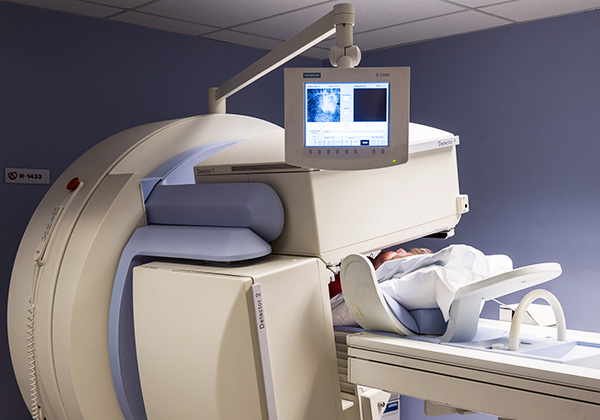Purpose

Nuclear stress myocardial perfusion imaging (MPI) is a nuclear cardiology test that shows how well blood flows to the muscle of the heart (myocardium). This test is used to diagnose the presence or absence of coronary artery disease.
Details
A radioactive tracer (called Myoview) is injected into the patient’s bloodstream and is taken up by the heart tissue. A single photon emission computed tomography (SPECT) camera detects the radiation released by the tracer to produce images of the heart. Two sets of images are taken, one after an injection at rest and another after an injection during a stress test – either exercise stress on a treadmill or drug-induced stress with persantine (dipyridamole) medication, which simulates exercise.
Description
- A nuclear technologist will explain the test to you and answer any questions you may have.
- You will receive an injection in the vein of one arm. The injection contains a small amount of radioactive material that will travel to your heart muscle.
- Approximately 45 minutes later, you will be brought into the scanner room and asked to lie on the table, with both arms positioned overhead. The SPECT camera will take a series of pictures for about 15 minutes. You will be asked to lie very still during this time to ensure that the images are clear.
- After these pictures are completed, adhesive electrodes will be applied to your chest to capture an electrocardiogram (ECG). The sites will be cleaned with alcohol and shaved if necessary. A mild abrasion may also be used to ensure an interference-free and continuous ECG recording.
- An intravenous line will be inserted in the vein of one arm.
- A stress technologist will explain the stress portion of the test to you and answer any questions you may have. Your blood pressure, heart rate, and ECG will be monitored before, during, and after the test.
- You will then undergo the stress test. The technologist will give you a second injection of the radioactive tracer.
- You will be monitored throughout the test. It is very important for you to tell the technologist if you experience any discomfort or other symptoms so that he/she may better assess when to stop the test. You should inform the technologist if you experience any shortness of breath, chest pain, arm pain, palpitations, difficulty walking, fatigue, headache, or other discomfort after the test.
- When the stress test is completed, you will have 30 to 45 minutes to eat a light meal.
- You will be brought into the scanner room again and asked to lie on the table, with both arms positioned overhead. The SPECT camera will take a series of pictures for about 15 minutes. You will be asked to lie very still during this time to ensure that the images are clear.
- The nuclear technologist will process the study. The data will be reviewed by a physician. A report will be sent to the doctor(s) involved in your care.
Patient instructions
Before Your Test
Follow the instructions provided by the imaging department.
After Your Test
If you are traveling by air or driving across the border within 24 to 48 hours after your test, you may set off the radiation sensors. Notify your technologist before leaving to receive written documentation.
Additional info
- When you come to the Heart Institute, please check in with central registration in the front lobby. Then proceed to the S-Level and wait in the waiting room for your name to be called.
- The nuclear stress test takes about four hours to complete.
- If you have any questions prior to your nuclear stress test, please call 613-696-7066, Monday to Friday, 7:30 a.m. to 4 p.m.
- About Myocardial Blood Flow with SPECT Imaging
The images below are interactive
Touring instructions: Click and drag your mouse anywhere in the picture to move about the room. On mobile devices, drag your finger to pan the scene and pinch to zoom in or out. By clicking or tapping the lowercase "i" hotspots, you will learn about the equipment in the room and how it is used.

